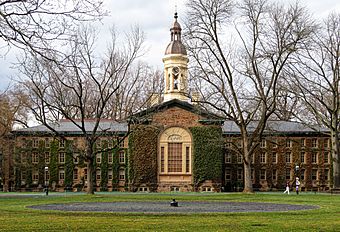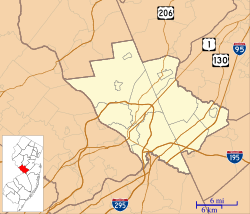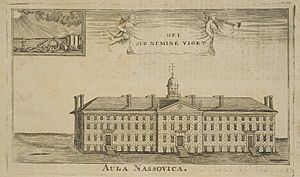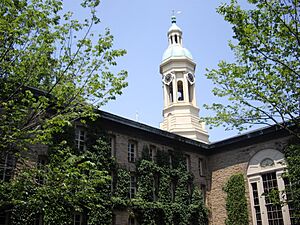Nassau Hall facts for kids
|
Nassau Hall, Princeton University
|
|
|
U.S. Historic district
Contributing property |
|
 |
|
| Location | Princeton, New Jersey |
|---|---|
| Built | 1756 |
| Architect | Robert Smith (1756), Benjamin Latrobe (1804), John Notman (1855) |
| Architectural style | Renaissance |
| Part of | Princeton Historic District (ID75001143) |
| NRHP reference No. | 66000465 |
Quick facts for kids Significant dates |
|
| Added to NRHP | October 15, 1966 |
| Designated NHL | October 9, 1960 |
Nassau Hall is the oldest building at Princeton University in Princeton, New Jersey. People sometimes call it Old Nassau. When it was built in 1756, it was the biggest building in colonial New Jersey. It was also the largest school building in the American colonies.
For four months in 1783, Nassau Hall was even the United States Capitol. This means it was where the U.S. government met.
The university, first called the College of New Jersey, held classes in other towns before Nassau Hall was finished. It was designed by Robert Smith. Later, famous architects like Benjamin Latrobe and John Notman helped rebuild it after fires. In its early days, Nassau Hall had classrooms, a library, a chapel, and rooms for students and teachers.
Contents
What's in a Name?
When Nassau Hall was built in 1754, the college wanted to name it after Jonathan Belcher. He was the governor of New Jersey. But he said no. He wanted it named after "the glorious King William III." King William III was from the Dutch House of Orange-Nassau. That's why the building is called Nassau Hall.
Nassau Hall's Role in History
Nassau Hall played a big part in American history. During the American Revolutionary War, both British and American soldiers used it. It was damaged a lot, especially during the Battle of Princeton on January 3, 1777.
Nassau Hall During the American Revolution
The British Redcoats took over Nassau Hall in 1776. American soldiers had to shoot at their own building to get it back. This happened during the Battle of Princeton. Three cannonballs were fired at the building. One hit the south side, and you can still see the damage today.
Another cannonball flew through a window. It hit a portrait of King George III, taking off his head in the painting. People say this cannonball came from a gun led by Alexander Hamilton. The Americans won this battle, and Nassau Hall was taken back.
Nassau Hall as the U.S. Capital
From June 30 to November 4, 1783, Princeton was the temporary capital of the United States. Nassau Hall became the place where the government met. The Congress of the Confederation used the building's library on the second floor.
During this time, Congress congratulated George Washington for ending the war. They also heard that the peace treaty with Great Britain was signed. The first foreign minister from the Netherlands came to the U.S. there.
Ivy Day Tradition
Since 1869, each graduating class at Princeton adds a new sprig of ivy to grow on the walls of Nassau Hall. This is a special tradition.
Nassau Hall on a Stamp
In 1956, a special U.S. postage stamp honored Nassau Hall. It was for the building's 200th birthday. The stamp showed the front of Nassau Hall. It was orange and cost 3 cents. It was first sold in Princeton, New Jersey.
Princeton's School Song
The song Old Nassau became Princeton University's official school song in 1859. The words were written by Harlan Page Peck, a student from the class of 1862. They were first printed in a magazine called Nassau Literary Magazine.
The music was written by Karl A. Langlotz. He was a music professor at Princeton. He created a new tune for the song's words.
Nassau Hall's Architecture
Nassau Hall has changed over time. When it was built in 1756, it had a simple design. A hallway went through the middle. It connected student rooms, classrooms, and a prayer hall. The library was above the main entrance.
The prayer hall was two stories tall. It had a balcony that could be reached from the second floor. The basement had a kitchen, dining area, and storage. There were about 40 rooms for students.
Fires and Rebuilding
On March 6, 1802, a fire badly damaged the inside of Nassau Hall. Only the outside walls were left. Almost all the books in the library were destroyed. Benjamin H. Latrobe, a famous architect, led the rebuilding. He added new features, like triangular shapes above the entrances.
Another fire hit the hall in March 1855. John Notman rebuilt it this time. He added a dome and towers in an Italian Renaissance style. Some of these additions were removed in later updates.
Today, Nassau Hall holds Princeton University's main offices. This includes the office of the university's president. The U.S. Department of the Interior named Nassau Hall a National Historic Landmark in 1960. This shows how important it is in the Revolutionary War and U.S. history.
Images for kids








